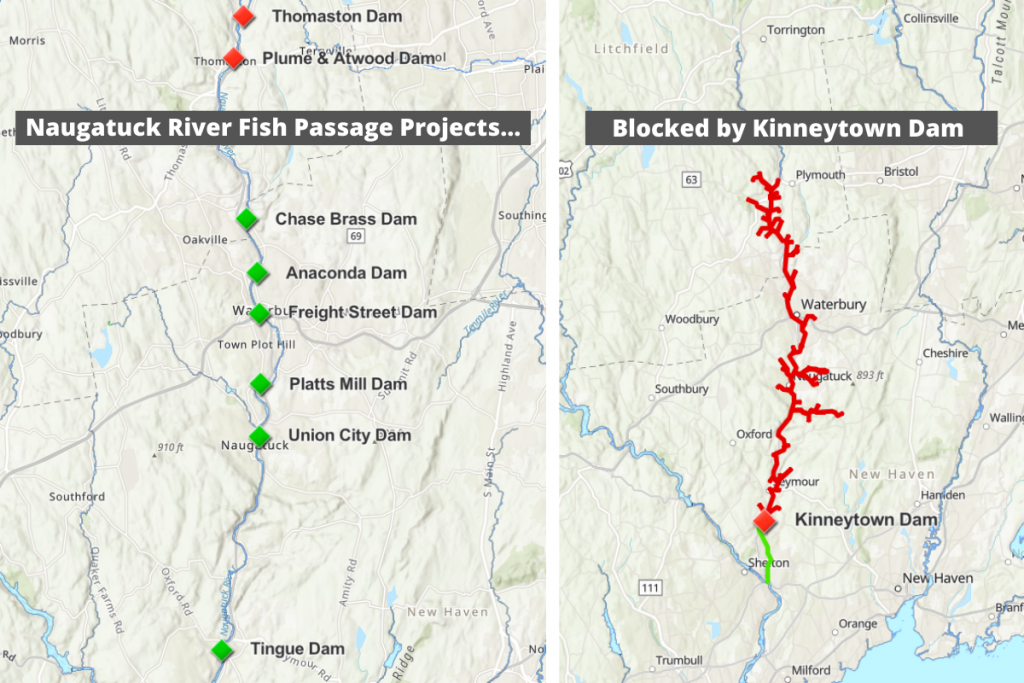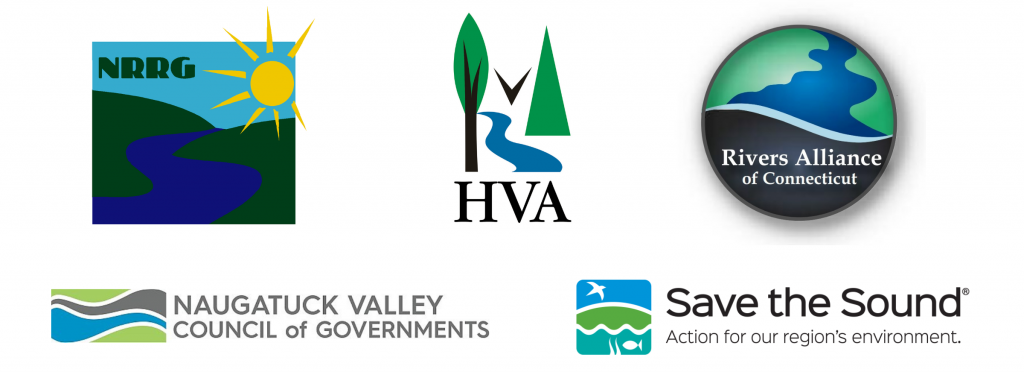
Kinneytown Dam, owned by Hydroland Corp., is the last remaining barrier to migratory fish on the Naugatuck River, blocking access to over 32 river miles of spawning habitat. Currently, fish are unable to pass the dam due to improper hydropower operations and an ineffective fish ladder. But support for restoring fish passage at Kinneytown is significant and growing. Building on a Federal Energy Regulatory Commission (FERC) investigation into the dam’s license compliance initiated by the U.S. Fish and Wildlife Service, Save the Sound joined with the Naugatuck River Revival Group (NRRG), 19 municipalities represented by the Naugatuck Valley Council of Governments, and other partners to form the Naugatuck River Restoration Coalition (NRRC). Together with community members across the state, the NRRC is organizing a concerted push for restoration of fish passage at Kinneytown Dam.
LATEST UPDATES:
- NVCOG’s collection of recent coalition comments on the FERC docket
- CT Post: “The dam that holds the key to the Naugatuck River’s rebirth”
- Press Release: Naugatuck Valley Council of Governments, Save the Sound, and Naugatuck River Revival Group take legal action to restore the Naugatuck River, hold Hydroland Corp. accountable
- Read the full complaint filed on September 30, 2021 by NVCOG, Save the Sound, and NRRG with the Federal Energy Regulatory Commission
- Valley Independent Sentinel: “Towns and Environmental Groups Target Kinneytown Dam Owner”
Great strides have been made in restoring the Naugatuck River over the last several decades. Residents used to know what was being manufactured upstream on any given day based on the color of the river; thanks to the Clean Water Act, it is now home to trophy trout fishing, numerous osprey nests, and a bald eagle nest. While there is still a long way to go and much work to do, water quality improvements have been a significant success story. Progress on removing barriers and reopening the river came in a burst of activity around the turn of the millennium, but now faces its most significant challenge yet.
Learn more about efforts to restore the Naugatuck River

With extensive upriver dam removals and fish passage completed, including a $6.3M investment in a bypass in Seymour, the Kinneytown Dam is the sole remaining barrier to restoring fish runs all the way from Long Island Sound to Thomaston.
Kinneytown Dam does feature a fish ladder constructed in 1999, which, if effective, would allow passage for select species of fish. However, due to a lack of maintenance and poor operation of the dam and its power works, very few fish—and for some species, none—are able to pass the dam en route to their historic spawning grounds upstream. The barrier to migratory fish at the Kinneytown Dam effectively renders the Tingue Dam bypass a $6.3 million stranded asset, and dilutes the impact of all of the other upstream dam removals by preventing the establishment of healthy anadromous runs that benefit many other species of wildlife and human economies.
The Naugatuck River Restoration Coalition will continue to lead the efforts to restore fish passage at Kinneytown Dam. To read more about this work, check out this list of resources and recent press coverage:
The Effort to Restore Migratory Fish to the Naugatuck River (story map)
Opinion: Let the Naugatuck River run silver again (CT Post op-ed)
Senator, environmentalists push for improvements to Kinneytown Dam (Channel 3 News)
Our Opportunity to Restore Fish Passage at Kinneytown Dam (blog post)

Contact the NRRC and sign up for updates
“To visit Kinneytown Dam at any time is to view a tired-looking cement monolith with giant horizontal cracks, numerous leaks, and bent rebar sticking out of it. But look closely in springtime and you will see the force of life pressing against the dam, hundreds of individual fish — even trout and salmon — frustrated in their attempts to move upriver to spawn. Some perish, their bodies drying in the sun. This occurs right next to a lengthy, zig-zagging engineered fish ladder intended to allow passage over the dam. It has been a failure.”
John Waldman, professor of biology at Queens College, N.Y., and author of “Running Silver: Restoring Atlantic Rivers and their Great Fish Migrations.” Read the full opinion piece in the CT Post.
